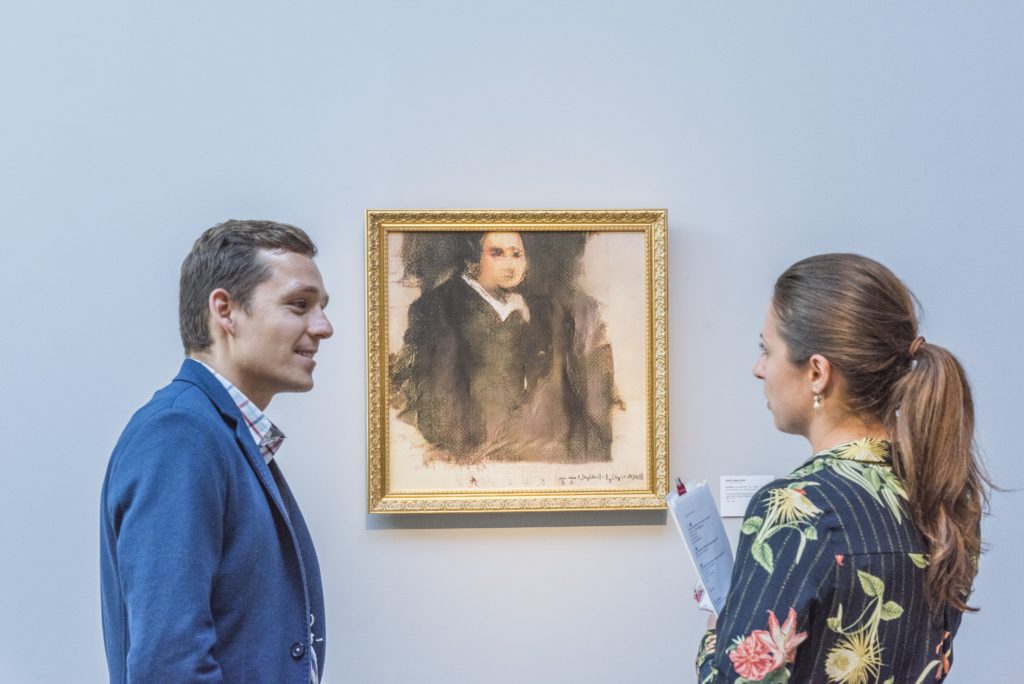As a visual artist, you may not consider yourself a writer, and that’s OK.
But your Artist Bio is an important piece of writing you do need to nail down.

You will need it for exhibition or gallery applications, artist websites, press releases, publicity materials, etc…
The good news is once you have it done and dusted, you won’t need to do it again!
At most, you will simply refine it over the years.
So read along, and let’s get your Bio done right…
Artist Statement and Artist Bio: What’s the difference?
The two powerful tools you can use to communicate the meaning and intentions behind your art to your audience are your artist statement and artist bio.
Your artist statement is a great way to share your creative process, inspiration, and philosophy with your audience. It’s like a manifesto for your art, where you can dive deep into what drives you to create and what you hope to achieve through your work.
On the other hand, your artist bio is like a snapshot of your artistic journey so far. It’s a potted history of your life as an artist, highlighting your achievements, experiences, and background. Your artist bio serves as an introduction to your work, and it helps your audience understand your perspective as an artist.
In other words, while your artist statement focuses on your art and medium, your artist bio is all about YOU as an artist.
When you introduce your art in your artist statement, it’s like saying, “Hey folks, check out my art!” But when it comes to your bio, you’re basically saying:
🙋♂️ “Hey folks, here’s a little bit about me!”
Important Considerations Before Crafting Your Artist Bio
We get it – talking about yourself can feel awkward, but the details about your passion, inspiration, and dreams are just as crucial as your artwork. People are naturally curious creatures, so it’s no surprise that viewers and readers want to know a bit about you. After all, your art is a reflection of who you are as a person and an artist.
There are a few things you might want to consider before you get started with your artist bio. Let’s go through them together!
✅ It’s OK to show a glimpse of your personality.
Starting off your artist bio with a hook is crucial to grabbing your readers’ attention.
A little bit of humor can go a long way in reeling them in and warming them up to both you and your art. So why not give it a shot and inject some personality into your bio?
✅ Your artist bio should not be too corporate—it’s not a CV or a resume.
When it comes to crafting your artist bio, it can be tempting to list out every single accomplishment and accolade you’ve received throughout your career.
But most of the time, less is often more.
Instead of overwhelming your readers with a laundry list of accomplishments, it’s important to be selective and choose only the most noteworthy and relevant highlights of your career. This will not only make your bio more concise and easier to read, but it will also give your readers a better sense of who you are as an artist.
Crafting Your Artist Bio: Tips and Tricks for Fine Artists
Okay, it’s time to roll up our sleeves and get started on writing that artist bio.

To help you out, we’ve gathered some handy tips and tricks that will make the process easier and more effective.
✅ Write in the third person (e.g., he, she, his, hers, they)
Have you ever considered what someone else might write about you if given the task of crafting your bio?
It may seem like a strange exercise, but putting yourself in someone else’s shoes and imagining what they might say about you can be an incredibly helpful tool in crafting your own bio.
This exercise can help you identify the most important aspects of your career and artistry from an outsider’s perspective, as well as highlight any strengths or unique qualities that may not have been immediately apparent to you.
So, what might someone else write about you? Perhaps they would focus on your bold use of color or your ability to create intricate and detailed works of art.
Maybe they would highlight your commitment to environmentalism and the use of sustainable materials in your artwork. Or perhaps they would focus on your professional accomplishments and exhibitions.
Regardless of what they might say, the exercise of imagining someone else’s perspective can help you gain clarity and insight into your own career and artistic identity.
Use these insights to inform your own bio and make it truly stand out to potential clients and fans.
✅ Keep it concise and straight to the point.
As a fine artist, you want your artist bio to leave a lasting impression on your readers – but you don’t want to bore them with a lengthy essay. That’s why it’s important to use simple and direct sentences that will keep your readers engaged and interested in what you have to say.
By using concise language and avoiding complex sentence structures, you can make your bio easy to read and understand. This will not only help to hold your reader’s attention, but it will also give them a better understanding of who you are as an artist and what you have to offer.
So, the next time you sit down to write your artist bio, remember to keep it simple and direct. Your readers will thank you for it. 😉
✅ Be creative.
Your creativity is your greatest asset – and that should extend to your artist bio as well. While it can be tempting to stick to a standard format or template, your bio is an opportunity to showcase your unique personality and artistic style.
So, don’t be afraid to get creative with your bio!
Your bio can be a combination of
➡️ where you came from
➡️ where you went to school
➡️ your inspirations
➡️ your artistic process and philosophy
➡️ your interests
➡️ and your accomplishments as a human being.
All of these add more dimension to your narrative. You can tackle different angles, but make sure that the subject is always your artistic development.
But let’s be real, how can you make your bio stand out and tell a compelling story?
One way is to use timelines and narrative progression to organize your thoughts and show your artistic journey in a clear and coherent manner. Break down your career highlights into different time periods, so readers can see how your work has evolved over time and how you have grown as an artist.
To get started, make sure your timelines are easy to follow. Use bullet points or subheadings to separate different phases of your career and highlight your key achievements and milestones from each era.
And don’t forget about the importance of narrative progression – by framing your career journey as a progression from past to present, you can help readers understand how each phase of your career has influenced the next.
With these tips in mind, you can create a killer artist bio that showcases your artistic development and highlights the unique qualities that make you a standout in your field.
Should Previous Non-Art Related Degrees and Jobs Be Included in an Artist Bio?

The answer is simple – yes, you may include them! Your bio is the perfect place to share your unique journey as an artist.
The trick to including non-art-related experiences in your bio is to connect them with your current artistic career. How did those experiences shape your perspective and inspire your work? For instance, if you worked in the field of child welfare, how did that experience influence your artistic vision?
Including non-art-related experiences can make you a more interesting artist and give viewers a deeper understanding of who you are as a person. It’s not just about your art degree but about the experiences that make you who you are today.
When writing your bio, don’t keep your previous jobs and degrees separate from your artistic career. Integrate them into your story and tell your audience how they have impacted your artistic process.
What’s the Perfect Length for Your Artist Bio?
If you have been wondering how long your biography should be, we’ve got you covered!
Here are some pointers to help you decide on the length of your artist bio:
✅ Your biography can be as short as a few paragraphs or as long as two to three or four pages. It really depends on how much information you want to include.
✅ If you want to keep it short and sweet, a brief summary or biographical statement at the back of your portfolio or on your website is perfectly fine. This gives a quick overview of your background and accomplishments.
✅ If you want to provide more detail, an extensive biography can be very helpful and effective in making sales. This can be from three to seven pages long, written in the third person, and laid out in a magazine-style format. This type of bio is ideal for artists who want to give collectors a more in-depth look at their life and career.
✅ Your biography is a document that can evolve over time and can grow or shrink in length. Keep it up to date with your latest achievements.
✅ Sharing your background, life, and career development can help establish additional credibility for you as an artist. Potential buyers find it fascinating, and it creates a deeper connection with them.
✅ You can combine your short bio with elements of your artist statement to weave together your work and life. This can make your bio a little lengthier, but it gives readers a more holistic view of your artistic vision and process.
There’s no one-size-fits-all answer to how long your artist bio should be. Consider your goals and the level of detail you want to share, and use that as a guide when crafting your biography.
Oops! Don’t Make These Mistakes When Writing Your Artist Bio
Did you make these mistakes when writing your artist bio? Don’t worry—it’s not too late to fix them! Let’s take a look at some of the most common pitfalls to avoid when crafting your artist bio.
✅ Poor Writing
When it comes to your artist bio, it’s crucial to make sure it’s well-written and polished. You don’t want any errors or awkward sentences to distract your audience from your amazing work.
So, take the time to proofread it multiple times and make sure it’s free of any mistakes. Even small writing errors can give off an unprofessional impression to your readers.
✅ Sharing too much information
While it can be tempting to include every detail of your life, it’s best to stick to information that is relevant to your artistic identity. Avoid sharing too much information about your personal life or unrelated accomplishments and instead focus on highlighting your artistic achievements and aspirations.
✅ Lack of personality
Let your artist bio be a reflection of your one-of-a-kind personality and style. Avoid using generic terms and concepts that make you sound like a robot. Instead, infuse your bio with your unique voice and perspective on life to make it stand out.
Ready to share your Artist Bio with the world? Here are a few things you should do first
So, you’ve written your artist bio, and you’re eager to share it with the world. But before you hit that publish button, there are a few crucial steps you should take to make sure your bio is polished and ready to impress.
✅ Read, reread, and proofread
Have you read your artist bio out loud yet? This is a crucial step in making sure that your bio sounds both natural and professional while still being approachable to your audience.
Now, chances are, your first draft is going to need a lot of trimming down. That’s why it’s important to reread it multiple times and make changes to any areas that need improvement.
And don’t forget to ask a friend to proofread it for you as well. They can give you valuable feedback on how to make it look and sound even better. Trust us, it’s always helpful to have a fresh set of eyes review your work!
✅ Have a fellow artist review your artist bio—hear that second opinion 😉

It’s always a good idea to have someone else take a look at your artist bio before sharing it with the world. And who better to turn to than a fellow artist? They can give you honest and objective feedback that can help you refine your message and make sure that your bio truly reflects your identity as an artist and your body of work.
So, if you have an artist friend who’s willing to take a look, don’t hesitate to send them a copy of your bio and ask for their thoughts. Ask them what they loved about it and what could be improved. Their insights could help clarify your message and make your bio even more effective.
How Often Should You Update Your Artist Bio?
Well, the answer is pretty straightforward – as often as you need to!
Your artist bio is an important tool for introducing yourself to potential buyers, galleries, and employers, so it should be kept up to date as your career progresses.
Revisiting your biography every year is a great way to ensure it still accurately represents your current work and achievements. As you continue to create new pieces and gain recognition, you’ll want to make sure your biography is showcasing your latest and greatest.
It’s easy to fall into the trap of using an outdated biography. You may have created a biography early on in your career, and it may not be relevant anymore. That’s okay! Take some time to review and update it, and make sure it reflects your current work and accomplishments.
Your artist bio is a BIG deal.
And the good news is that once you have it ready, you feel a BIG relief.
It’s what can set you apart from the rest and help you connect with your audience. So, when you sit down to write it, take your time and put in the effort to craft something that really reflects who you are as an artist.
Your bio can add that extra layer of interest and intrigue to your art, so make it count!
Want one on one help with your bio? If you would like to have word-by-word artist bio templates, your own bio revised and edited by a professional art writer, then consider applying to our flagship program – the Professional Artist Accelerator.



